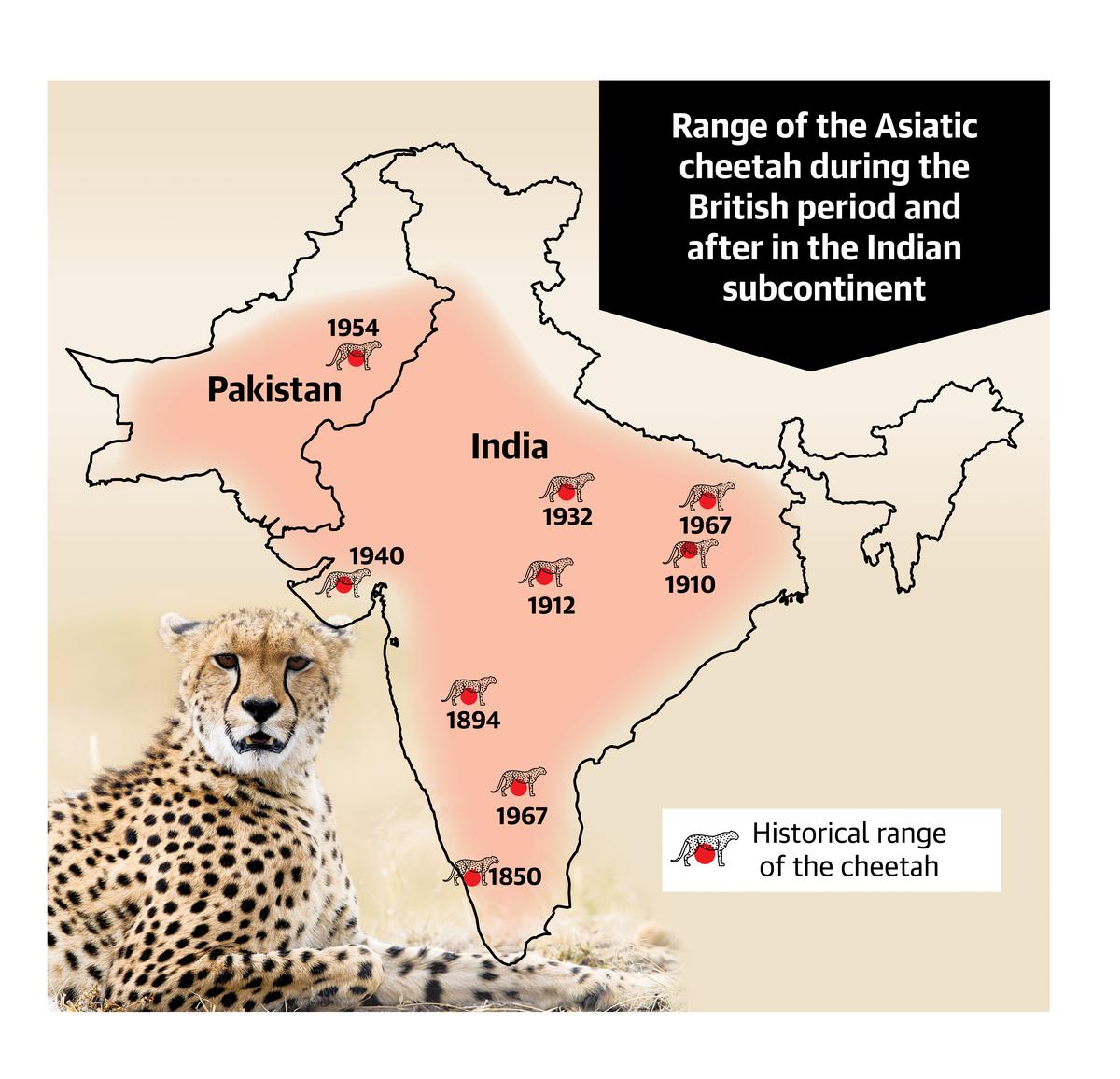Context
-
The African cheetahs, which became extinct in India after Independence, is all set to return with the Union Government launching an action plan. According to the plan, about 50 of these big cats will be introduced in the next five years, from the Africa savannas, home to cheetahs, an endangered species.
Distribution of cheetahs in India
- Historically, Asiatic cheetahs had a very wide distribution in India.
- There are authentic reports of their occurrence from as far north as Punjab to Tirunelveli district in southern Tamil Nadu, from Gujarat and Rajasthan in the west to Bengal in the east.
- Most of the records are from a belt extending from Gujarat passing through Maharashtra, Madhya Pradesh, Uttar Pradesh, Chhattisgarh, Jharkhand and Odisha.
- There is also a cluster of reports from southern Maharashtra extending to parts of Karnataka, Telangana, Kerala and Tamil Nadu.
- The distribution range of the cheetah was wide and spread all over the subcontinent. They occurred in substantial numbers.
- The cheetah’s habitat was also diverse, favouring the more open habitats: scrub forests, dry grasslands, savannahs and other arid and semi-arid open habitats.
- Some of the last reports of cheetahs in India prior to their local extinction are from edge habitats of sal forests in east-central India, not necessarily their preferred habitat.
- In Iran, the last surviving population of wild Asiatic cheetahs are found in hilly terrain, foothills and rocky valleys within a desert ecosystem, spread across seven provinces of Yazd, Semnan, Esfahan, North Khorasan, South Khorasan, Khorasan Razavi and Kerman.
What caused the extinction of cheetahs in India?
- The consistent and widespread capture of cheetahs from the wild (both male and female) over centuries
- its reduced levels of genetic heterogeneity due to a historical genetic bottleneck resulting in reduced fecundity and high infant mortality in the wild,
- its inability to breed in captivity,
- ‘sport’ hunting and
- finally the bounty killings are the major reasons for the extinction of the Asiatic cheetah in India.
- It is reported that the Mughal Emperor Akbar had kept 1,000 cheetahs in his menagerie.
- The cheetah numbers were fast depleting by the end of the 18th century even though their prey base and habitat survived till much later. It is recorded that the last cheetahs were shot in India in 1947, but there are credible reports of sightings of the cat till about 1967.
What are the conservation objectives of introducing African cheetahs in India?
- Based on the available evidence it is difficult to conclude that the decision to introduce the African cheetah in India is based on science.
- Science is being used as a legitimising tool for what seems to be a politically influenced conservation goal.
- This also in turn sidelines conservation priorities, an order of the Supreme Court, socio-economic constraints and academic rigour.
- The issue calls for an open and informed debate.

Credit: The Hindu - The officially stated goal is: Establish viable cheetah metapopulation in India that allows the cheetah to perform its functional role as a top predator and to provide space for the expansion of the cheetah within its historical range thereby contributing to its global conservation efforts.
- Apart from establishing a cheetah population in India, the stated objectives include: To use the cheetah as a charismatic flagship and umbrella species to garner resources for restoring open forest and savanna systems that will benefit biodiversity and ecosystem services from these ecosystems.
- Enhance India’s capacity to sequester carbon through ecosystem restoration activities in cheetah conservation areas and thereby contribute towards the global climate change mitigation goals.
Arguments against re-introduction
- African cheetahs are not required to perform the role of the top predator in these habitats when the site (Kuno) that they have identified already has a resident population of leopards, transient tigers and is also the site for the translocation of Asiatic lions as ordered by the Supreme Court of India in 2013. In other open dry habitats in India there are species performing this role, e.g., wolf and caracal, both of which are highly endangered and need urgent conservation attention.
- Such a small number of cats at very few sites cannot meet the stated goal of performing its ecological function at any significant scale to have real on ground impact. Clearly, there are far more cost-effective, efficient, speedier and more inclusive ways to conserve grasslands and other open ecosystems of India.
- Asiatic lions and a variety of species already found in these ecosystems can very well perform this role and more.
- If the government is serious about restoration and protection of these habitats, it first needs to remove grasslands from the category of wastelands and prevent further degradation, fragmentation and destruction of these habitats.
- Investing directly in science-based restoration and inclusive protection of these ecosystems will yield results much more quickly and sustainably than the introduction of African cheetahs.
Conclusion
- Given all the challenges, especially the lack of extensive areas extending in hundreds if not thousands of square kilometres with sufficient density of suitable prey, it is very unlikely that African cheetahs would ever establish themselves in India as a truly wild and self-perpetuating population.
- A likely unfortunate consequence of this initiative will be the diversion of scarce conservation resources, distraction from the real conservation priorities and a further delay in the translocation of lions to Kuno.
Reference:
Visit Abhiyan PEDIA (One of the Most Followed / Recommended) for UPSC Revisions: Click Here
IAS Abhiyan is now on Telegram: Click on the Below link to Join our Channels to stay Updated
IAS Abhiyan Official: Click Here to Join
For UPSC Mains Value Edition (Facts, Quotes, Best Practices, Case Studies): Click Here to Join
